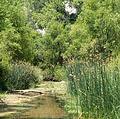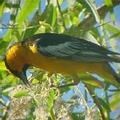 美國、加拿大和澳洲科學家所組成的研究團隊發現,生物體內的基因不只能控制單一生物體的特性,且具有支配同一群落裡其他生物行為的能力。他們指出這些基因組影響整個生態的演化,而主導整個研究的北亞利桑那大學教授惠特翰(Tom Whitham)指出,「我們正邁入一個全新的研究領域。」
美國、加拿大和澳洲科學家所組成的研究團隊發現,生物體內的基因不只能控制單一生物體的特性,且具有支配同一群落裡其他生物行為的能力。他們指出這些基因組影響整個生態的演化,而主導整個研究的北亞利桑那大學教授惠特翰(Tom Whitham)指出,「我們正邁入一個全新的研究領域。」
惠特翰表示:「目前我們所做的,是專注在一種基礎物種,因為並不是所有的物種在生態學上都具有相同的重要性。」在這次研究中的基礎物種,或者說關鍵物種是白楊木,這是第一棵所有的基因序列已經完全被解讀排列、比對出來的樹。
目前研究人員關注的基因,主要是控制白楊木裡單寧酸濃度的基因,白楊木是美國西部濱水棲息地的主要植物。不同的白楊木個體或基因型都含有不同濃度的單寧酸。
惠特翰表示,受到基因控制的單寧酸濃度推動了一整座白楊木樹林的結構,或表現型(phenotype)。單寧酸影響了白楊木落葉的分解速率,因而接著影響土壤的肥沃度,接著受影響的是土壤中的微生物,然後是居住在土壤裡或者食用這些落葉的昆蟲,再影響仰賴這些昆蟲維生的鳥類,如此這般環環相扣彼此影響。
在《遺傳學自然評論》7月號和《進化》5月號 裡,惠特翰及其同事討論這樣的生物表現型在生態學程度來說是可遺傳的。也就是說,一棵樹的後代很可能支持了他們的父母所支持的同一個有機體社群以及生態系統的進展。
這樣的推論意義深遠,不論棲息的破壞和氣候變遷而影響各種保育生物多樣性的努力。種植基因不同的樹將造成從屬的社群中其他物種的多樣性。樹木的生物多樣性越豐富,相關物種在環境破壞的情況下存活的機會越大。
北亞歷桑納大學的博士後研究員,同時也是這份研究共同作者之一的史懷哲表示:「光是拯救珍貴和瀕臨滅種的物種是不夠的。我們必須拯救基礎物種的基因多樣性。擁有這些基礎物種的高度基因多樣性才是對抗未來各種變動的保險。」
 A team of scientists from the United States, Canada and Australia has found that the genes of one organism not only control the characteristics of that individual but also dictate the behavior of thousands of other organisms in a community. They say these genes influence the evolution of an entire ecosystem. "We're pushing a whole new field of research," said lead investigator Tom Whitham at Northern Arizona University.
A team of scientists from the United States, Canada and Australia has found that the genes of one organism not only control the characteristics of that individual but also dictate the behavior of thousands of other organisms in a community. They say these genes influence the evolution of an entire ecosystem. "We're pushing a whole new field of research," said lead investigator Tom Whitham at Northern Arizona University.
"What we’ve done is zero in on a foundation species, because not all species are as equally important ecologically," Whitham said. The foundation, or key, species in this case is the cottonwood tree, which is the first tree to have all its genes sequenced, or mapped.
Among the genes under study are those that control the level of tannins in cottonwoods, which are dominant trees in riparian habitats in the West. Different individuals, or genotypes, of cottonwoods have different levels of tannins.
These genetically controlled tannin levels drive the structure, or phenotype, of a riparian forest, Whitham says. Tannins affect the decomposition rate of cottonwood leaves, which in turn affects the fertility of soils, which affects the microbes in the soil, which affect the insects that live in the soil or eat the leaves, which affect the birds that feed on the insects, and so on.
In the July issue of "Nature Reviews Genetics" and the May issue of "Evolution," Whitham and fellow researchers discuss how this phenotype is heritable on an ecosystem level. That is, the progeny of a tree are likely to support the same communities of organisms and ecosystem processes that their parents supported.
The implications are far reaching, affecting efforts to conserve biodiversity in the face of habitat destruction and climate change. Planting trees that are genetically diverse will result in increased diversity of other species in the dependent community. The greater the tree diversity, the greater the chance of associated species surviving environmental degradation.
"It’s not enough to save rare and endangered species. We need to save genetic diversity in the foundation species," said study co-author Jennifer Schweitzer, a postdoctoral researcher at NAU. "Having high genetic diversity in these foundation species is insurance against changes in the future."






